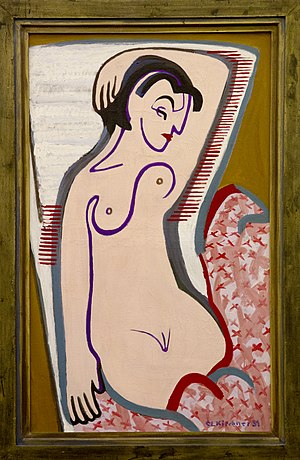Naked woman lying down

|
| Naked woman lying down |
|---|
| Ernst Ludwig Kirchner , 1931 |
| Oil on canvas |
| 150 × 90 cm |
| Kirchner Museum Davos , Davos |
The Naked Reclining Woman is a painting by Ernst Ludwig Kirchner from 1931. It is in the Kirchner Museum Davos , where it is part of the exhibition “Alles Kirchner! The Museum as a Chamber of Wonder ”, which was shown from June 5 to November 6, 2016. The work is a gift from Ernst Ludwig Kirchner's estate in 1990.
description
It shows a naked woman with her arm over her head. The head is tilted slightly so that her left hand is touching her right ear. Since the title of the picture says that she is lying down, it can be assumed that a lying pose was painted. But the mattress is shown vertically, so that it could also be a mirror. The woman is not shown in full, her legs are missing or indicated by a sweeping line that separates the body from the ceiling. Her eyes are half closed, which suggests that she is thinking. There is also a wrinkle on her forehead that emphasizes the impression of reflection. Nevertheless, she appears relaxed because of her posture and has an erotic attraction due to the nudity. But in the work it is not just a woman's body that can be seen, but also letters that only reveal themselves at second glance. The breasts are connected to the S, the face can be read as a W, the legs are separated from the ceiling by the M and connected to the M-shaped forehead crease. The body is thus also a symbol.
meaning
Until the 1970s, handing over one's head was considered a criterion for school readiness. The so-called Philippine measure measured a child's ability to attend school based on their physical proportions. If a child was able to touch his right ear with his left hand, he was considered ready for school and started school. The pose of the reclining woman is reminiscent of the Slumbering Venus by the Italian Renaissance painter Giorgione from the early 16th century. The woman as a model has a patriarchal tradition in painting as an object of desire. Even with Ernst Ludwig Kirchner, lust as a man's fantasy knows no bounds. The focus is on lust, so that women appear as connoisseurs of their bodies. In Ernst Ludwig Kirchner's work, the woman's body is also a message body, since its representation contains letters. The woman becomes a book from which a story can be read. The letter W on the face closes W-questions (who, where, what). The woman opposite was his equal. Ernst Ludwig Kirchner strove for equal relationships and at the same time propagated free love . He wanted to live comradely relationships with women, as he himself called it:
"I also got the longed-for comrade spiritually" (...)
Ernst Ludwig Kirchner was a founding member of the Brücke (artist group) , which also propagated life reform and maintained a hedonistic lifestyle.
literature
- Hyang-Sook Kim: The depictions of women in the work of Ernst Ludwig Kirchner. Hidden self-confessions of the painter. Dissertation . Tectum-Verlag, Marburg 2002, ISBN 3-8288-8407-5 , pp. 62-72.
- Carl Georg Heise (ed.): Portraits of the bridge artists from each other. No. 63, Philipp Reclam jun, Stuttgart 1961.
- Karl Brix: Ernst Ludwig Kirchner, Small Artist Monograph. Verlag der Kunst, Dresden 1991, ISBN 3-364-00232-0 .
- Hyun Ae Lee: But I'm going to set up a new Kirchner again. Waxmann Verlag, Münster 2008, ISBN 978-3-8309-2056-4 . (Excerpts from books.google.ch )
Individual evidence
- ^ Exhibition catalog painting for the exhibition “Alles Kirchner! The Museum as a Chamber of Wonder ”from June 5 to November 6, 2016 in the Kirchner Museum Davos
- ↑ Hyun Ae Lee: But I'm going to set up a new Kirchner again. Waxmann Verlag, Münster 2008, ISBN 978-3-8309-2056-4 , p. 129 (excerpts from books.google.ch )
- ↑ Hyang-Sook Kim: The woman as an object of male curiosity. In: Hyang-Sook Kim: The depictions of women in the work of Ernst Ludwig Kirchner. Hidden self-confessions of the painter. Tectum-Verlag, Marburg 2002, ISBN 3-8288-8407-5 , p. 72.
- ↑ Model of the comradeship connection between the sexes. In: Katharina Sykora: Femininity, Big City, Modernity. Museum Education Service, Berlin 1996, p. 22.
- ↑ Thomas Röske: Ernst Ludwig Kirchner - Dance between women. Art monograph. Insel Verlag, Frankfurt am Main / Leipzig 1993, ISBN 3-458-33264-2 , p. 61.
- ↑ Quotation from: EL Kirchner catalog 1880–1938. Neue Nationalgalerie, Berlin 1980, p. 60.
- ^ Ernst Kirchner's Streetwalkers: Art, Luxury, and Immorality in Berlin, 1913–1916. In: The Art Bulletin. March 2000, accessed October 1, 2016. (English)